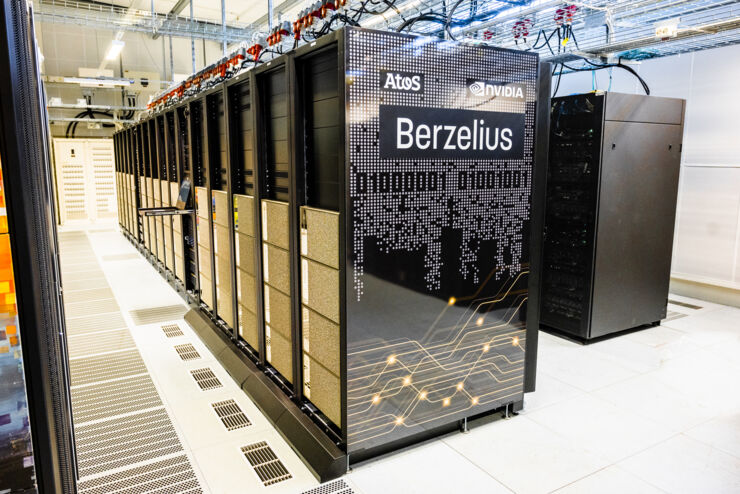March 23, 2021 – Linköping University announced that Berzelius, Sweden’s fastest supercomputer for AI and machine learning workloads, has been launched.
The supercomputer is located at the National Supercomputing Center. It is based on the NVIDIA DGX SuperPOD computing infrastructure and delivers 300 petaflops of AI performance. Berzelius was made possible by a donation of EUR 29.5 million from the Knut and Alice Wallenberg Foundation.
The purpose of the system is to enable world-leading research in Sweden in the field of AI, machine learning, and data-driven science. The supercomputer will be instrumental for research at the university and research in the Swedish industry collaboration with the Swedish academia.
The supercomputer is named in honour of Jöns Jacob Berzelius, who helped pioneer chemistry 200 years ago. And it’s only fitting that his name is given to another colossal innovation in science. The Berzelius system will be twice as fast as Sweden’s current top computer and would rank among the top 10 per cent on the latest list of the world’s TOP500 supercomputers, describes Nvidia.
Berzelius puts Sweden at the forefront of AI and ML
The launch was marked by the online inauguration of Berzelius, at which Jan-Ingvar Jönsson, Vice-Chancellor of Linköping University, Marcus Wallenberg, Vice-Chair of the Knut and Alice Wallenberg Foundation, Nvidia’s CEO and founder Jensen Huang, Pierre Barnabé, Senior Executive Vice-President and Head of the Big Data and Cybersecurity Division at Atos and Anders Ynnerman, professor of scientific visualisation at Linköping University and program director for Wasp, gave their addressing speech regarding the supercomputer launch.
“This is a fantastic opportunity for Sweden to be a leading nation in Artificial Intelligence, Machine Learning and the new era of life sciences,” expressed Jan-Ingvar Jönsson. “It will provide researchers with a fantastic possibility to pursue research tasks that were not possible before. With regard to the international perspective, it puts Sweden on the global map and in the competitive race towards AI-Driven business and society. Also, it will make it possible for Swedish researchers to compete among the global vanguard in AI.
“One of the most important aspects of driving innovation going forward will be the computational power offered today. Therefore, Berzelius will be a cornerstone in achieving this route to a more innovative Sweden,” stated Marcus Wallenberg.
“In every phase of science, there was an instrument that was essential to advancing science. Every single generation had its instrument of science, and the instrument of science today is the supercomputer. On the one hand, it’s a virtual laboratory where drugs can be discovered, new planets and stars can be discovered. It’s also a computer science collaboration because, for the very first time, this computer can write software that we can’t possibly write and help us solve problems we couldn’t before.” summarised Jensen Huang.
“The researchers that will be attracted to this system will enable the Swedish ecosystem to transform itself from an industrial technology leader to a global technology leader”, added Jensen Huang.
Talking about the long-term impact of the facility, Jensen said that with Berzelius, what Marcus and the Knut and Alice Wallenberg Foundation have done is create conditions by which Sweden could be at the forefront of technology, discovery in science and the breakthrough field in computer science.
“Research in machine learning requires enormous quantities of data that must be stored, transported and processed during the training phase. Berzelius is a resource of a completely new order of magnitude in Sweden for this purpose, and it will make it possible for Swedish researchers to compete among the global vanguard in AI”, says Anders Ynnerman.
A part of the AI agenda
The Berzelius supercomputer will be included in projects that aim to make huge strides forward in areas like wireless communications, cybersecurity, large-scale IoT and efficient programming. It will enable Swedish researchers to collaborate with their colleagues at Nanyang Technological University (NTU) in Singapore on finding new ways to enhance data analytics with visualisation, developing more secure AI algorithms and orchestrating multiple AI models to work as one to schedule the NTU’s campus bus network.
All these activities as part of Sweden’s largest private research initiative focused on AI innovation – WASP, Wallenberg Artificial Intelligence, Autonomous Systems and Software Program.
The latest and fastest addition to the supercomputer family
For the team of experts at the Linköping University, hosting world-class supercomputers is nothing new. The National Supercomputing Center is home to six other supercomputers, including the Tetralith consisting of 1908 compute nodes. The Tetralith was the most powerful supercomputer in Scandinavia after its installation in 2018 until now. But Sweden’s new supercomputer Berzelius is twice as fast as Tetralith, opening up new possibilities in compute power.
Under the hood of Berzelius supercomputer
“The Berzelius supercomputer is a result of a long journey involving research programmes, universities, Nvidia and Atos to define the best solution for AI research supporting programmes such as WASP. It’s the largest AI platform deployed in Sweden and will become the fastest supercomputer in the country. The configuration will allow end-users and developers to start running AI simulations on the NVIDIA DGX SuperPOD”, said Pierre Barnabé.
The system features networks from Nvidia, application tools from Atos, and storage capacity from DDN. The machine has been delivered and installed by Atos. More specifically, Berzelius comprises 60 Nvidia DGX™ A100 systems interconnected with Nvidia Mellanox™ HDR 200 Gb/s Infini Band networking and four DDN AI400X™ with NVMe. The Atos Codex AI Suite will support researchers in using the system efficiently.
For more information, visit Nvidia’s blog and Linköping University’s press release.













Add comment